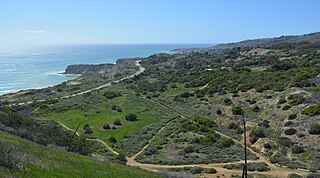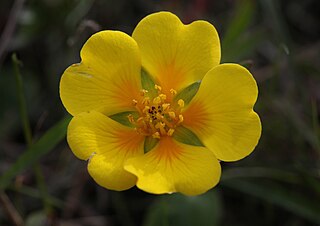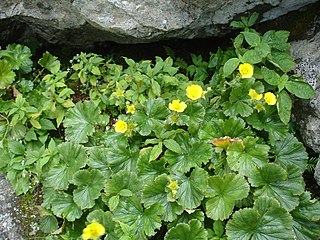
Rancho Palos Verdes is a coastal city located in Los Angeles County, California atop the bluffs of the Palos Verdes Peninsula, neighboring other cities in the Palos Verdes Hills, including Palos Verdes Estates, Rolling Hills and Rolling Hills Estates. Rancho Palos Verdes is known for its dramatic views of the Pacific Ocean, Santa Catalina Island, and Los Angeles, as well as for its highly-ranked schools, extensive horse and hiking trails, and for being one of the wealthiest ZIP codes in the United States in terms of household income and property prices.

The El Segundo blue is a rare subspecies of the square-spotted blue butterfly. It is endemic to a small dune ecosystem in Southern California that used to be a community called Palisades del Rey, close to the Los Angeles International Airport (LAX). In 1976 it became a federally designated endangered species. This butterfly’s habitat has been substantially reduced due to urban development and invasive plants, and it now exists as a handful of populations restricted to coastal dunes in the vicinity of Los Angeles.

The Palos Verdes blue is a small endangered butterfly native to the Palos Verdes Peninsula in southwest Los Angeles County, California, United States. As its distribution has been proven to be limited to one single site it has one of the best claims to being the world's rarest butterfly.

Ridgway's hawk(Buteo ridgwayi) is a bird of prey in the family Accipitridae endemic to the island of Hispaniola in the Caribbean. It is classified as Critically Endangered because of habitat destruction and human persecution in the Dominican Republic; however, due to conservation efforts, the population is now increasing.

The Palos Verdes Peninsula is a landform and a geographic sub-region of the Los Angeles metropolitan area, within southwestern Los Angeles County in the U.S. state of California. Located in the South Bay region, the peninsula contains a group of cities in the Palos Verdes Hills, including Palos Verdes Estates, Rancho Palos Verdes, Rolling Hills and Rolling Hills Estates, as well as the unincorporated community of Westfield/Academy Hill. The South Bay city of Torrance borders the peninsula on the north, the Pacific Ocean is on the west and south, and the Port of Los Angeles is east. As of the 2010 Census, the population of the Palos Verdes Peninsula is 65,008.

The Portuguese Bend region is the largest area of natural vegetation remaining on the Palos Verdes Peninsula, in Los Angeles County, California. Though once slated for development including the projected route of Crenshaw Boulevard, the area is geologically unstable and is unsuitable for building.
Palos Verdes Peninsula Unified School District (PVPUSD) is a school district headquartered in Palos Verdes Estates, California with facilities in all four cities of the Palos Verdes Peninsula.

Coastal sage scrub, also known as coastal scrub, CSS, or soft chaparral, is a low scrubland plant community of the California coastal sage and chaparral subecoregion, found in coastal California and northwestern coastal Baja California. It is within the California chaparral and woodlands ecoregion, of the Mediterranean forests, woodlands, and scrub biome.

Potentilla hickmanii is an endangered perennial herb of the rose family. This rare plant species is found in a narrowly restricted range in two locations in coastal northern California, in Monterey County, and in very small colonies in San Mateo County. This small wildflower, endemic to western slopes of the outer coastal range along the Pacific Ocean coast, produces bright yellow blossoms through spring and summer.

The Catalina Island Conservancy is a nonprofit organization established to protect and restore Santa Catalina Island, California. The Conservancy was established in 1972 through the efforts of the Wrigley and Offield families. The Conservancy was created when both families deeded 42,135 acres (170.51 km2) of the island over to the organization—88% of the Island.
Pentachaeta bellidiflora, the white-rayed pentachaeta or whiteray pygmydaisy, is a Californian wildflower in the genus Pentachaeta of the family Asteraceae. It is included in both the state and federal lists of endangered species.

Callicarpa ampla, also called the capa rose, is a species of plant in the family Lamiaceae. It is found in Puerto Rico in the Caribbean region. It is threatened by habitat loss and is a critically endangered plant species.
Calyptranthes thomasiana is a rare species of plant in the family Myrtaceae. It is found on three islands in the Caribbean. There are fewer than 250 individuals total divided amongst the islands of Vieques in Puerto Rico, St. John in the United States Virgin Islands, and Virgin Gorda in the British Virgin Islands. It has been extirpated from the wild on Saint Thomas, U.S. Virgin Islands, where it was first described in 1855, and now only grows there in cultivation.

Cercocarpus traskiae, known by the common names Santa Catalina Island mountain-mahogany and Catalina mahogany, is a rare species of plant in the rose family.

Astragalus brauntonii is a rare species of milkvetch known by the common name Braunton's milkvetch. It is endemic to California, where it is known from fewer than 20 extant occurrences in the hills and mountains surrounding the Los Angeles Basin in Southern California. This is a federally listed endangered species in the United States.

The Palos Verdes Hills are a low mountain range on the southwestern coast of Los Angeles County, California. They sit atop the Palos Verdes Peninsula, a sub-region of the Los Angeles metropolitan area.

Santa Catalina Island is a rocky island off the coast of Southern California in the Gulf of Santa Catalina. The island name is often shortened to Catalina Island or just Catalina. The island is 22 mi (35 km) long and 8 mi (13 km) across at its greatest width. The island is located about 29 mi (47 km) south-southwest of Long Beach, California. The highest point on the island is Mount Orizaba. Geologically, Santa Catalina is part of the Channel Islands of California archipelago and lies within Los Angeles County. Catalina Island is the easternmost of the Channel Islands. Politically, Catalina Island is part of Los Angeles County in District 4. Most of the land on the island is unincorporated with 90% of the population living in the city of Avalon.

The Palos Verdes Peninsula Land Conservancy (PVPLC) is a non-profit organization that is based on the Palos Verdes Peninsula in southwestern Los Angeles County, California.

Sibara filifolia, the Santa Cruz Island winged rockcress or Santa Cruz Island rockcress, is a rare species of flowering plant in the family Brassicaceae. It is endemic to the Channel Islands of California, where it is now known from a few occurrences on San Clemente Island and one population on Catalina Island.

Geum radiatum is a rare species of flowering plant in the rose family known by the common names spreading avens, Appalachian avens, and cliff avens. It is native to the region of the border between Tennessee and North Carolina in the southeastern United States, where there are eleven known populations remaining. The plant was federally listed as an endangered species in 1990.

















